#van gennep
Text

Kees Nieuwenhuijzen, Ted Joans: 'Mijn zwarte gedachten. Een manifest', Van Gennep, Amsterdam, 1970 [Dutch Graphic Roots]
#graphic design#typography#geometry#poetry#book#cover#book cover#kees nieuwenhuijzen#van gennep#dutch graphic roots#1970s
60 notes
·
View notes
Text
Los espacios liminales
CAPITULO 1 "Nostalgia"
"Los espacios liminales son objeto de una estética de Internet que retrata lugares vacíos o abandonados que parecen inquietantes, desolados y, a menudo, surrealistas. Perteneciente al concepto de liminalidad, los espacios liminales pueden ser lugares de transición, como pasillos o áreas de descanso, pero también lugares con un atractivo nostálgico, como parques infantiles y casas vacías. En general, las imágenes del espacio liminal representan lugares anormalmente vacíos y oníricos."
Eso que leíste fue lo primero que me salió en Wikipedia al buscar "espacios liminales", como fue dicho anteriormente los espacios liminales representan un lugar que puede ser inquietante y solitarias, pero a la vez representan lugares nostálgicos, como podría ser una estación de tren, estos lugares sin importar si lo viste en una película o en la vida real, se puede decir que son lugares concurridos, pero que sentirías si vieras un lugar así vacío.

Estos lugares a menudo estos lugares generan inseguridad, ya el simple echo de estar solos ya genera este sentimiento pero hay otros que lo generan mas, el no estar solos.
CAPITULO 2 "LOS BACKROOMS"
Cerca del 2022 se popularizo el tema de los backrooms lugares peligrosos donde estaban fuera de nuestro alcance, o casi, el tema es que si buscas imágenes de los backrooms seguramente encuentres imágenes como estas

aunque no todas sean así, pone un lugar inquietante, "un lugar liminal", anuqué no se les puede considerara así debido que puedes encontrar cosas en estos lugares que va con lo contrario a "un lugar liminal"
CAPITULO 3 "LIMINAL"
los "espacios liminales" y "liminal" no son lo mismo, entonces podría surgirte esta pregunta que es o a que se entiende por "liminal", se entiende por liminal aquel espacio o experiencia de transición de un momento o una etapa a otra. El término fue acuñado por Arnold van Gennep a principios del siglo XX, con su libro de investigación etnográfica "Los ritos de paso" (1909), que gira en torno a la manera en la que las culturas más antiguas realizaban ritos que parecían estar en otra dimensión transitoria: una especie de limbo entre el plano terrenal y otro superior, más allá del entendimiento humano. Lo liminal apela a un momento antes del límite (que viene de limens, su raíz etimológica en latín) que existe entre las cosas, en el que se experimenta una sensación de estar fuera de lugar, desorbitado, como algo alterno.
Autor: N.G
#espacios liminales#textobreve#backrooms#estación de tren#Arnold van Gennep#Los ritos de paso#pokerssirio21#texto
1 note
·
View note
Text

Plats à viande et sièges sculptés du Zambèse
from M.A. van, Gennep. Guide Sommaire du Musée Ethnographique: Ville de Neuchâtel, 1914
Meat plates and sculpted seats of the Zambèse
b/w studio photograph
133 notes
·
View notes
Text











Whatever the variations of detail, a series which conforms to the general pattern of rites of passage can always be discerned.
The Rites of Passage, Arnold van Gennep
#this took forever jesus christ. those fucking pictures killed me#anyway took a page out of sat's book by making them all the same colour so they all fit together#sw
33 notes
·
View notes
Text

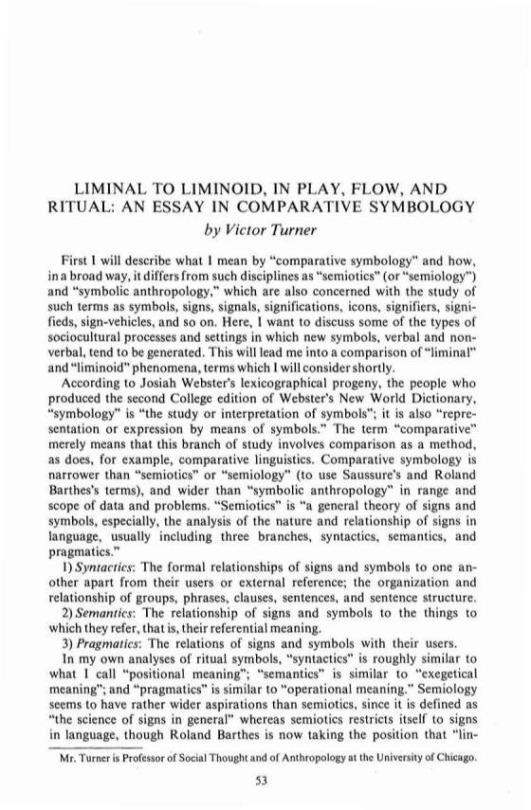


Liminality in Anthropology Applied to Magical Ritual
Let’s first look at Liminality from an anthropological perspective. Described as the quality of ambiguity or disorientation that occurs in the middle stage of a rite of passage, when participants no longer hold their pre-ritual status but have not yet begun the transition to the status they will hold when the rite is complete, by Victor Turner, the concept was first developed by folklorist Arnold van Gennep in the early 20th century and, condensed for our purposes here, applied to rites of passage in small-scale societies. Think tribal rites for a boy becoming a man.
Now, as we know in magic, liminal spaces are the places in between. We apply this to physical places, mental spaces, spiritual realms, dates, times, etc. So when it comes to liminality in magical rites and rituals, we’re weaving, and exploring these ideas together. So, as we look at van Gennep’s structure for a rite of passage, we see what parts intrinsically apply to magical ritual, and what we can learn from them.
Three-Fold Structure
pre-liminal rites - rites of separation; metaphorical “death”, initiate is forced to leave something behind by breaking with previous practices and routines (ego-death, anyone?)
liminal rites - transition rites; two characteristics: must follow a strictly prescribed sequence, where everybody knows what to do and how | everything must be done under the authority of a master of ceremonies. There is a destruction that allows for considerable changes to be made to the identity of the initiate. Middle stage “implies an actual passing through the threshold that marks the boundary between two phases…”
postliminal rites - rites of incorporation; initiate is re-incorporated into society with a new identity, as a “new” being.
…I don’t know about anyone else, but that just screams magical ritual to me.
Now, these Rites of Passage have been practiced by societies all over the world, for longer than archeologists probably know, sometimes even being led by shaman. These rites may have begun as magical ritual. What can we learn from them? In what new ways can we think of Liminality? Might being more aware of pre-liminal rites and postliminal rites bring us new oneness with our liminal spaces? Once you go down the rabbit hole, there’s a lot to unpack.
❤️🔥Kat
#witchcraft#esoteric#magic#witchlr#liminal#witches of tumblr#ritual#halloween#samhain#hedge witch#dark one#high strangeness#aliens#hellcat#anthropology#magick#aleister crowley#elemental#occult#occulltism#dark art#fortean#macabre#spirituality#ancestors#spirit guides
22 notes
·
View notes
Text


For Dutch architect Onno Greiner (1924-2010) the psychological function of architecture always prevailed over the material and technical, an attitude that manifested itself in complex and restrained buildings that reveal their quality on the inside rather than on the outside. Not surprisingly Greiner’s major building tasks were psychological institutions, cultural centers, theaters and office buildings. In all of them Greiner sought to balance the collective and the individual, a characteristic that was sparked during his early involvement with the discourse around structuralism in architecture.
In the present catalogue of selected projects, published in 1985 by Van Gennep and edited by Marc van der Marck, the previously mentioned characteristics of Greiner’s architecture are easily discernible from a wealth of photos and plans: covering some 25 years of architectural work the book features key projects like the „De Viersprong“ psychotherapeutic center in Halsteren and the cultural centers „De Tamboer“ in Hoogeveen and „De Flit“ in Amersfoort. The qualities of these buildings and the characteristic juxtaposition of open and intimate spaces first and foremost shows in the floor plans since photographs can barely transport this key aspect of Greiner’s architecture.
This being said the present volume is a perfect starting point for further research into the work of a very interesting yet somewhat lesser-known protagonist of Dutch postwar architecture.
30 notes
·
View notes
Text
@poke-maniac
I am making this post because it was too frustrating replying in the comments section of the original post.
“ I said that money was a mean to make his company more successful as he himself admits, not just for power's sake.”
Yes, but I wonder what making his company more successful would do to the amount of power he wields. Could it be that it would generate MORE power for him??????????????
“Which is more or less confirmed in sinister war, but since you ignore everything that happens after post OMD as if nothing was canon anymore, I guess you don't see it as a valid argument.”
It’s more than just that I discount it for being post-OMD. From what you have described of Sinister War I do not see how this goes against anything I have said. Norman wanted to money to make his company more successful. But in doing this he makes himself more powerful.
The priority is ALWAYS power. In fact, few people who are rich assholes as you put it are in it for the sake of money alone, but predominantly for the POWER that money grants them.
But even if we argue that there those who really are JUST in it for the money, Norman isn’t one of them as he literally told us that in ASM #40:



Oh look, Norman EXPLICTELY saying that he needed to become wealthy because that was the only way he could become POWERFUL!
“We shouldn't apply real life psychology to fictional people,”
This is, simply put, one of the most astronomically bad takes I have ever had the misfortune of reading.
There is so much to unpack with this, but let’s just get down to the basics. If we aren’t going to apply real life psychology to fictional people what the fuck does the term ‘believable character’ even mean. How are they believable if not in terms of who they are, what they think, what they feel, how they act is psychologically realistic. Because that is what psychology boils down to ‘what is happening inside of a human being to make them behave the way they behave’.
Second of all, there is a GIGANTIC overlap between the mental muscles and psychologists and good writers flex for the very obvious reason that both jobs entail getting inside people’s heads. Its just that for writers those people happen to be fictional.
The proof in the pudding of this is Carl Jung, perhaps the second most famous psychologist behind Freud himself, and indeed was at a time viewed by Freud as his heir in the field of psychology. Jung’s works are massive and complicated to explain but one of the things he often brought up was the connection between psychology and mythology/fairy tales/folklore.
“Like Freud, the psychologist Carl Jung also took myths seriously. Jung believed that myths and dreams were expressions of the collective unconscious, in that they express core ideas that are part of the human species as a whole. In other words, myths express wisdom that has been encoded in all humans, perhaps by means of evolution or through some spiritual process. For Jungians, this common origin in the collective unconscious explains why myths from societies at the opposite ends of the earth can be strikingly similar. ”-
This school of thought is eventually what led literature professor Joseph Campbell to study myths from various cultures and write his landmark book ‘The Hero with a Thousand Faces’. Here is a wikipedia excerpt about the book:
“The book includes a discussion of "the hero's journey" by using the Freudian concepts popular in the 1940s and 1950s. Campbell's theory incorporates a mixture of Jungian archetypes, unconscious forces, and Arnold van Gennep's structuring of rites of passage rituals to provide some illumination.[4] ”-
So psychology and storytelling are inherently intertwined and ALWAYS have been.
Third of all, there is no end of examples of critically acclaimed works of fiction that DO apply real life psychology to fictional people. Breaking Bad is one seasons long epic exploring the realistic psychological change of Walter White into a drug kingpin.
The Sopranos stemmed from creator David Chase’s psychological struggles with his mother and the therapy he went through to try and deal with it. Not only was it applying psychological realism to these fictional gangsters (and their families) but it went so far as to have a psychologist as a main character and make her sessions with Tony Soprano integral to the plot/character exploration of Tony himself.
And, just in case you were trying to say ‘fictional comic book people’, Batman’s villains are regarded as the best villains in mainstream comic book history in large part because because of their psychological complexities. There is literally a podcast hosted by a real life psychologist where they review and apply psychological realism to every episode of Batman the Animated Series:
The fact that she was able to do that at all speaks to how clearly the writers WERE applying real life psychology when writing Batman the Animated Series, the most transparent example being ‘Mad Love’, the origin of Harley Quinn. not only was Harley a psychologist herself, but her origin story stemmed directly fro co-creator Paul Dini's experiences with therapy and includes one of your so called 'Freuduan excuses' for why Harley is the way she is:
"Paul Dini: I’m no stranger to therapy. I was spending some time in therapy and was in my head a lot around that time. Bruce and I were discussing her origin one day over lunch, because I had been approached by DC to do a special issue of the comic, and we were talking about what if there was some sort of surprise to her origin? What if she’s not just a hench girl? We came up with the idea that she had been a doctor at Arkham Asylum and the Joker had gotten into her head and worked her into being his follower. … Then we thought, what if Harley’s in the role of the long-suffering girlfriend?
There was also an element of the fans who write to a prisoner who committed a terrible crime and say, “I understand you… I see the good in you,” and sometimes develop a relationship."

Bill Mantlo literally name dropped a psychological term during one of his 1980s Spider-Man stories. They got the term wrong, but the desire to use it at all when it wasn’t necessary ever so slightly hints that comic book writers frequently DO try to apply psychological realism to these fictional people.

Iconic Iron Man writer/prolific Spider-Man writer/co-creator of Venom and Carnage David Michelinie featured a psychologist character in at least two of his Spider-Man stories and used his insights as a way for Spider-Man to defeat both Doc Ock and Venom.


Bruce Banner/the Hulk is a character who hinges upon psychological realism. The entire premise of the character is that he has disassociative identity disorder and that the famous green savage Hulk everyone knows is an expression of his traumatised inner child throwing a gamma fuelled temper tantrum.
Peter David, who has written MANY Spider-Man stories including the iconic ‘Death of Jean DeWolff’, literally wrote an issue that took place inside Bruce Banner’s mind and where his fragmented identity (Bruce banner, Green Hulk, Grey Hulk) is made whole; an issue outright called 'Honey I Shrunk the Hulk' (as in head shrink).



(Oh look, an abusive father who hit Bruce. Guess the Hulk's origin doesn't make sense and is shit now too).
PAD’s Hulk yarn wasn’t the only Marvel story in the 1990s that literally dives into the head of a fictional person (i.e. the most blatant example of trying to apply psychological realism to them). There was also two stories that did exactly that with symbiotic serial killer Carnage:


One of those characters was Dr Ashley Kafka, a psychologist supporting character introduced for Spider-Man stories.
Hmmm…why would Spider-Man comics introduce a psychologist as a supporting character? Well, there could be various uses for a character like that but perhaps one of them might be to offer realistic psychological insights into these fictional people. Fictional people like Venom.

Or Vermin.


Or the Chameleon.
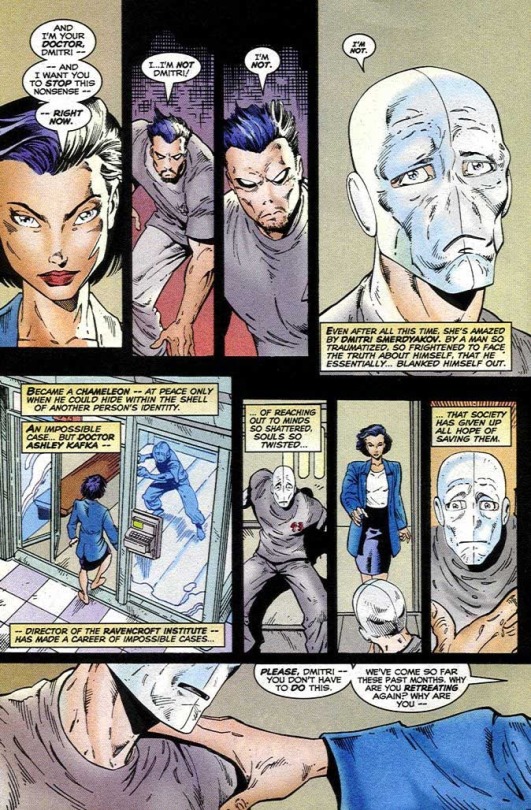
Hey, who created Ashley Kafka anyway?
It was prolific comic book writer J.M. DeMatteis. I wonder why he was so prolific, I mean what sort of stories has he done over at DC?

Oh…a story that acts as a psychological exploration of the Joker and his relationship to Batman. Fun fact, this story was originally rejects by DC because it was too similar to the Killing Joke…because it was also a psychological exploration of the Joker and his relationship to Batman.
Over at Marvel though, other than creating Ashley Kafka, what did J.M. DeMatteis write?
Oh, that’s right….
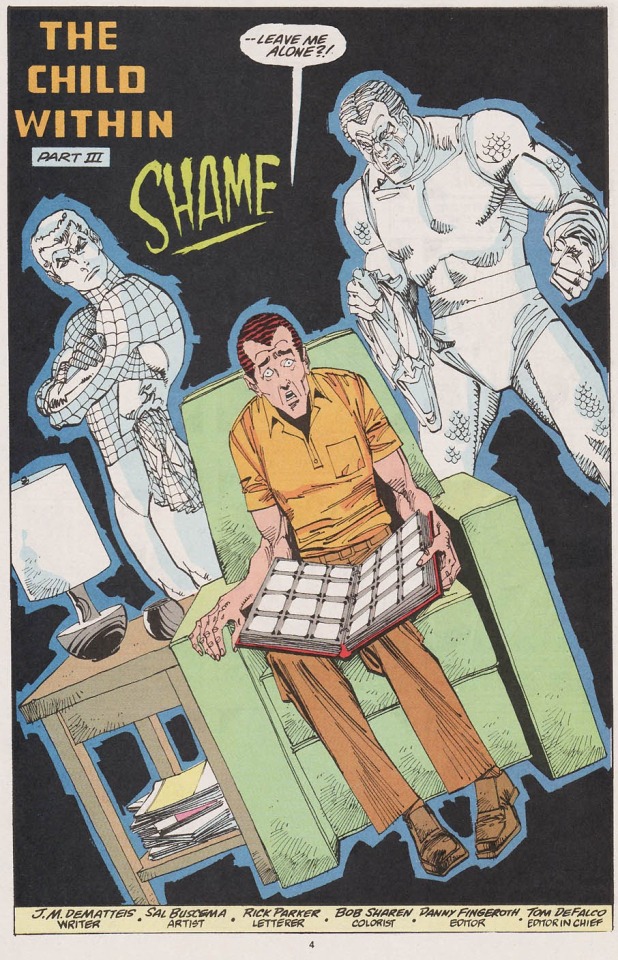
And...

And...

And...

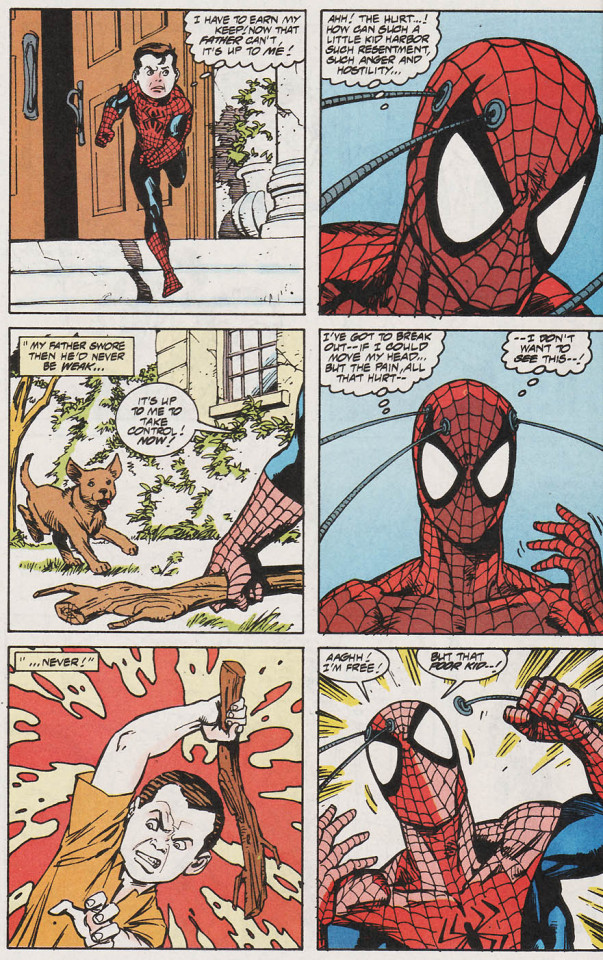


He wrote many of the stories we’ve been talking about this whole time. He was the guy who retconned the origin of Norman and Harry Osborn and explored Norman’s childhood in the first place.
Now it is a sad reality that there isn’t a single direct quote from DeMatteis proving he did in fact try to apply psychological realism when writing fictional people…
"We write about the things that obsess us. The themes in a writer’s work are the themes of a writer’s life. The Big Theme that has always obsessed me is the search for meaning, for personal, and cosmic, identity. Who are we? Why are we here? What’s the meaning of it all? Exploring those ideas, from both a psychological and spiritual perspective, is the driving force behind many of my stories, whether they’re more personal projects like Moonshadow or more popular ones like Spider-Man."
"I enjoy reading books about psychology and spirituality, books that explore the shadowed caverns of our psyches and the luminous castles of our souls."
"All the clever plotting in the world won’t help if it’s not grounded in psychologically real, relatable, characters."
"Peter Parker is one of the most psychologically and emotionally real characters in the history of comics"
"Harry and Peter are both very complex people, which meant that while the superhero action played out there was lots of room for psychological and emotional exploration."
…there are MULTIPLE direct quotes proving exactly that.
So YES we categorically should apply real life psychology to fictional people!
“ especially that nothing suggests in canon that his [Norman Osborn’s] dad was beating him to "feel powe[rful]”
I’ve said before and I will say it again, that is EXACTLY what is suggested by Spec Annual 1994 and Revenge of the Green Goblin.

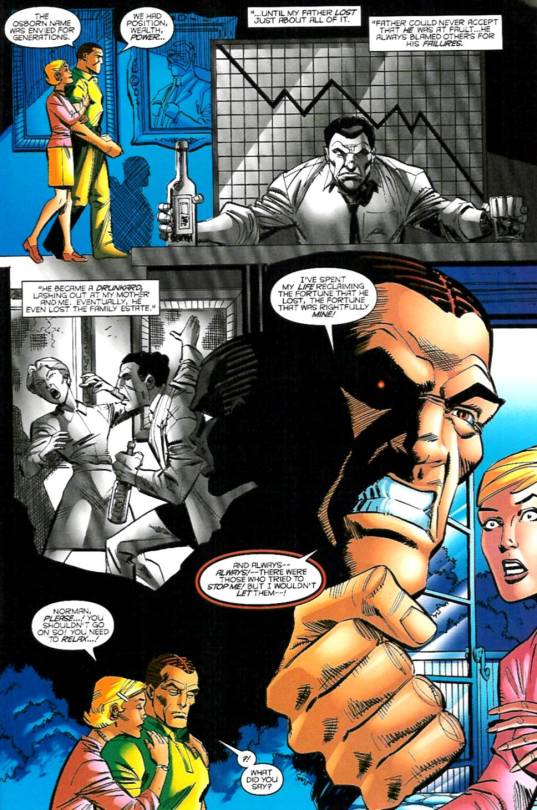
Norman's Dad loses the business and lashes at his son but this had NOTHING to do with him feeling powerless?
What do you think it means when someone feels powerless?
What do you think it means when someone of the old school tries to reaffirm that they are still 'a man'?
It is about power!
“All that's textually said is that he was lashing out on his family, in rage like many people irl when they lose everything.”
Yes but why would someone IRL lash out when they lose everything.
*gasp!*
You don’t possibly think they do that because losing everything makes them feel powerless and bullying someone else in turn makes them feel powerful, do you????????????? Feeling powerful couldn’t possibly be the root cause of why anyone bullies anyone else ever could it????????????????????????????????????????
Its almost like in textually saying he was lashing out because he lost everything it made him feel powerful or something?
Oh and by the way, ever so slightly undermined your own argument there. “We shouldn't apply real life psychology to fictional people,” vs. “…was lashing out on his family, in rage like many people irl when they lose everything.”
Which is it?
(not to mention if we aren’t supposed to apply real life psychology to fictional people why were you doing exactly that with your avatar examples?)
“Yeah the amnesia part never made any sense to begin with. It's said that the formula made him worse yet it doesn't seem to affect "amnesic" Norman all that much. Maybe it does? Because we don't see him all that much during his amnesia periods.”
We see PLENTY of Norman when he has amnesia.


So no the formula does not affect norman when he has amnesia.
But an idea slightly suggested in ASM #40 and then eventually confirmed in Revenge of the Green goblin was that the formula made norman worse because in giving him powers it acted as proof he was superior to everyone else, in other words it sent him on a huge ego trip.

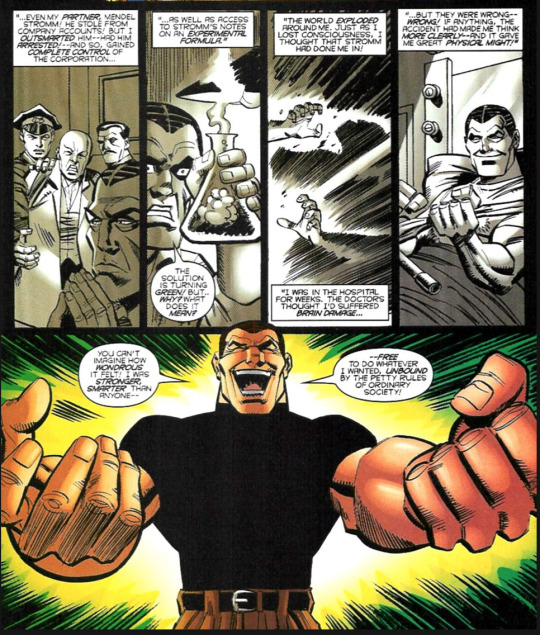
You know what would be interesting? If this Norman Osborn guy who is on a big ego/power trip formed a rivalry with a superhero who began his career on a big ego trip before being humbled. Especially if that hero’s defining philosophy was ‘with great power there must also come great responsibility…
“It honestly looks like a cheap excuse to keep him from telling the truth more than anything”
And as originally written by Stan, it was exactly that. It was taboo for a villain to know the hero’s identity back in the 1960s, or at least for them to go on living with that knowledge. Later stories however addressed this.
“But anyway, it just makes weird that his amnesia would make him a completely different guy if he was the same ashole during this specific time period he remembers (before Harry high school years).”
You haven’t been listening to me at all. You have never once addressed what I have said on this subject.
But I will repeat it again:
WE ARE THE PRODUCT OF OUR MEMORIES! IF YOU CHANGE THE MEMORIES YOU CHANGE THE PERSON!
You want a quick fictional example of this? The Arnie movie Total Recall.
In other words, the ONLY logical explanation for Norman becoming nice is because he DIDN’T just forget his memories after he became the Goblin. He forgot MORE than just that. Which is what happens with real life amnesia. You don’t just forget a set time period.
Yes the narrative has Spider-Man claim it is just everything after the accident that turned him into the Goblin, but how the fuck does Spider-Man know that for sure?
What we have is an objective flashback showing us exactly what Norman was like before the accident, we have objective on the page evidence of what he was like after the accident and we have objective on the page evidence of what he was like post amnesia. Post-accident is basically a bigger jerk of who he was pre-accident. Post-amensia is at odds with both versions.
The ONLY explanation that makes sense is that he didn’t simply forget the last few years, he forgot more than that. he forgot whatever life experiences shaped him into a bad person, or at least he couldn’t remember them clearly. Perhaps he could remember events but not the feelings associated with them.
This syncs up with how IRL amnesia works and reconciles everything, whether you look at the stories in the 1960s on their own or look beyond that decade.
“One could argue that he gradually became more and more neglectful. If Harry is just in denial as he can't see faults in his dad's parenting why did he spot a difference then? If his dad was acting the same as he always did, why would he be only in denial over how his dad acted prior to accident?”
Yeah MAYBE he did become more and more neglectful, but there is nothing on page suggesting that. We just know he WAS neglectful.
But alright, the idea that from Harry’s POV there was a time when things were better but got way worse before the accident, that could fit with the original story.
You know what else could fit just as well? That Harry is in denial. Because he wants/needs to believe at some point he and his Dad had a positive relationship when they actually never did.
Denial doesn’t work on the basis that it is 100% consistent all of the time. Norman was MUCH worse after the accident and Harry was also older and less impressionable and that change occurred within the last few years of his life circa ASM #39. All those factors combined make it entirely possible that he found it harder to deny that his Dad had changed. He’d gone from neglecting him and palming him off to almost entirely isolating himself and become more outspokenly verbally abusive and belittling.
Both were bad situations, but one was much worse.
Oh and be careful, because you almost sound like you are trying to apply real life psychology to counter my points. I thought we weren’t supposed to do that with fictional people?
“Why only complain about his dad's recent outbursts? It's clear that his dad is acting differently towards him. They had some good time together (despite his dad's obssesion over work) before the accident then his behavior towards Harry changed.”
No they didn’t. That’s the point of the story. They DIDN’T have good times together, but by the end of ASM #40 they now hopefully can have good times together.
The ASM #40 flashbacks are the deal breaker on all this. These aren’t simply flashbacks from Norman or Harry’s POV, these are from the omniscient POV as what they are depicting is not in line with what Norman is claiming. And they are not in line with what Harry was claiming in ASm #39 either.
Harry was NOT having a good time ever in those flashbacks and Norman was NOT being a good father.
Thing simply got WORSE after the accident.
Why is it so hard for you to buy into the idea that Harry is in denial?
Your approach is ‘Harry made this claim in a piece of dialogue therefore it MUST be completely true’. Even though the very next issue disproves it. Norman even says ‘I tried to be a pal to Harry’, he uses that exact word ‘pal’. And we see from those flashbacks that, no, he was not being a pal to Harry. He was being a shitty father. He was neglecting him, not talking to him, not engaging him or spending time with him.
So Norman is in denial and that was the point of the scene. BUT Harry, who has his DNA, couldn’t POSSIBLY be in denial also? There simply MUST be these magical phantom scenes we coincidentally never got to see where in fact they were BFFs?
Why is that more believable than ‘both father and son are mentally messed up’.
“Also bad person =/= bad father.”
That lacks nuance. You can be a good parent but in other ways a bad person, that is true.
But if you are a bad parent (specifically abusive, neglectful, putting yourself ahead of your child) you are as a matter of fact a bad person. There is nothing more important than raising a child.
“I'm just arguing about his parenting, not his morality,”
In this situation they are one and the same thing.
The things that make Norman a bad person are in turn what led to him being a bad father. He doesn’t have the ability to be a good father because he is a bad person.
During the Stan run, Norman pre-accident was also a bad parent and a bad person but to a lesser degree. That’s all there is to it. he railroaded his partner. He stole his innovations. He was after money and power. He neglected his son and priotised his pursuit of power ahead of his son’s wellbeing.
That is a BAD person, it just isn’t a total fucking monster which is what the retcons developed him into.
“we don't see much of him during his amnesia period to conclude that he was an all around a good person, just that he was a better dad.”
*pinches bridge of nose*
During his amnesia period (and excluding the period where he was in the process of remembering he was the Goblin) was Norman neglecting his son? No. Was he railroading his business partners? No. Was he stealing their inventions? No.
Oh, he WASN’T doing the things we saw him doing in the pre-flashbacks. But you know what he WAS doing? Being nice to his son. Spending time with his son. Making his son happy.
Hmmmm…its almost as if the things ASM #40 showed us about how pre-accident Norman was a bad person were either absent or directly the opposite with amnesiac Norman.
“But yeah, you're right, this amnesia plot device makes no sense no matter how you look at it but to me it looks like the implications is that his personality was reset before his accident. But to each their own, I guess .”
A story can imply one thing but show another or contradict itself. What is actually happening is more important than implications.
“I agree that Norman abusive background explains why he treats Harry so horribly as it was textually explained, as well as why he's so comfortable with his own darkness, his toxic masculinity but it doesn't explain as well why he became so obsessed with restoring his family's name, wealth, having social power.”
BECAUSE HIS DAD LOST THAT!
Do I actually need to explain that children are heavily influenced by their parents? That they subconsciously look to their parents as role models, that they seek their approval, that how their parents treats them shapes who they grow up to be?
If Norman’s Dad LOST the family’s prestige and was obviously upset about it and that in turn led to him hurting Norman OF COURSE Norman would want to restore it. He would have learned that prestige was important. Thus in restoring on some subcionsious level he’d:
Be making his father proud
Proving himself BETTER than the man who was his physical superior
Avoiding becoming like his father who he saw broken down and rendered weak by losing the company
Making himself powerful and therefore not weak, not like his father who was rendered weak/the helpless weak little boy his father bullied
“It's not about real life psychology, it's all about WRITING.”
THOSE AMOUNT TO THE SAME THING!
You can’t BE a good character writing without applying real life psychology! Because to be a good character writer you NEED to make your characters psychologically convincing, otherwise nobody would buy into them.
See above when I disproved your bullshit about not applying psychology to fiction.
You don’t NEED to have a psychology degree to write good characters but you do NEED to be able to get inside a fictional person’s head and render them as believable. And that would entail making them psychologically realistic.
William Shakespeare never studied psychology. He literally couldn’t have. But he was nevertheless able to write psychologically convincing characters that we CAN successfully apply real life psychology to.
Because writers and psychologists have this gigantic overlap in their respective fields, namely, getting inside people’s heads!
“Writing a proper Freudian excuse that doesn't require ton of meta analysis, real life psychology, conjecture.”
THERE IS NO CONJECTURE! The narrative SPELLS this all out explictely!
“And I'm not denying that it might be one of the factors, but it unlike his abuse of his own son, it's not used explain why he became so fixated on restoring his family's name,”
If Norman’s Dad abused him because the family business was fucked there would obviously be an inherent link between restoring the family business and the abuse he suffered.
This isn’t a Freudian excuse, it is basic bitch literary analysis. High schoolers could grasp this.
Norman didn’t want to be weak as he was when his dad hurt him. Norman didn’t want to be weak as his father was upon losing the business. His dad hurt him because he was upset about losing the business.
Therefore, in hitting Norman, in abusing him, it acted as a powerful motivator later in life to restore the family business.
It. Is. All. There.
“obtaining social power (not just physical) expanding the Osborn legacy”
You need to understand this, not just for the sake of this argument nor for your future reading of fiction, but just plain old navigating through life itself.
Power is power.
If you are made to feel physically powerless you 100% could go on to seek social power.
If a boss makes someone feel powerless at work they could leave work and make themselves feel sexually powerful by having sex with a hooker who they ask to call them ‘boss’ in the bedroom.
If your business is failing and your money is running out so you feel financially powerless and are losing social power there is a strong possibility that you’d hit your own child to feel powerful! Just as Norman’s Dad did.
You keep belligerently REJECTING the idea that there can be a link between social power and physical power but that is the truth of the matter. Not only have I known this for years through, you know, common sense, not only have I read up about this, but just to make 100% certain I am not wrong on this I asked someone I know personally who is a professional psychologist. She confirmed exactly what I’ve been saying.
Norman’s situation is entirely realistic. Which again, is no surprise, since it was written by a DeMatteis who was heavily into psychology and was himself friends with a professional psychologist who he based Ashley Kafka upon.
Oh, but I forgot, we don’t apply IRL psychology to fictional people right? But…if we aren’t doing that…why are YOU insisting that there can be no link between social and physical power??????????????????????????
And furthermore, expanding the Osborn legacy? Yeah, powerful people have wanted to insure they have a legacy to live on after they die since time began. That hasn’t even got anything to do with abuse or psychology. That is just how most animals are wired. We want our offspring to survive us and thrive. For Norman that meant his son and company would be strong
“, why he's a psychopath who loves killing people when we he doesn't get any benefit from it (like this guard's wife) .”
*groans*
He likes killing people because it is an exercise of his power. He is a power addict. He wants more and more power and wants to use it. No one takes power and DOESN’T use it.
Killing people makes him feel powerful.
He wants to feel that way because as a child he was made to feel powerless and saw his dad lose his power.
It is as simple as that.
And you seem to be ASKING for a psychological explanation there? I thought we don’t apply that to fictional people?
Why are you asking why someone is a PSYCHOpath but reject the PSYCHOlogical explanations I’ve been providing for it?
“It doesn't automatically explain IT ALL.”
It literally does. You are just being blind to that reality.
“It's not expanded on.”
There were 3 stories exploring it across nearly 10 years.
That expands upon it pretty well.
“It's not used to explain HOW it shaped his view on power, how it shaped his ruthless and psychopathic, personality (well unless you claim it's unborn ).”
I’m so exhausted at this point. It HAS been used to explain it. It explained it blindingly obviously. I have repeated it multiple times in this post let alone all the other ones I have made during this argument.
I have to ask now if you are trolling or if you are honestly just this blind?
And, again….asking for HOW something shaped someone’s view on power, HOW it shaped their personality? Gosh…that sounds like you are asking for a psychological explanation…but one where we cannot apply real life psychology apparently.
“I just wished that this backstory was more expanded on to show HOW it shaped him”
You literally admitted you haven’t read all the stories I mentioned so how can you possibly complain about all that.
You are complaining that something wasn’t explained when
It was explained IN Revenge of the Green Goblin
RotGG itself was an expansion of Spec Annual 1994, which you said you hadn’t read
“Like, there's so much things going on with him and the authors did the minimum they could,”
They wrote THREE stories exploring Norman and Harry’s childhoods and how those shaped them!
Roger Stern.
J.M. DeMatteis.
Paul Jenkins
Howard Mackie.
FOUR people between 1993-2000 wrote THREE different stories exploring this subject and this is the ‘minimum they could’?
Fucking Hell, what more do you want?
“as if we as readers are automatically supposed to connect all dots just from the knowledge alone that his dad beat him up and that it made him feel weak, so viewed toxic masculinity as "strength" and that it made him accept his own darkness.”
The. Story. Literally. Spells. This. Out!
Go. Read. The. Above. Pages!
But also, I, as a TEN YEAR OLD, understood this from Revenge of the Green Goblin alone. I didn’t even need the Child Within or Spec Annual 1994 to GET it!
It was REALLY obvious.
I’m not saying it should have been subtle…but also it was absolutely NEVER subtle.
To say readers are supposed to automatically connect the dots is saying ‘I have REALLY limited reading comprehension skills and need to be spoon-fed info.’
“Just how are we supposed to expand it to explain his psychopathy, his obsession with restoring his family's legacy which is primary motivation for most of what he does that's not connected to Peter (like the Gathering of five).”
See above. I’ve explained how it is all connected. Better yet read the stories. Though I doubt in this case it will make much difference.
“ This is made even more confusing with Sinister war”
A post-OMD story making things confusing? The shock I have. Its almost as if there was a reason I cut off with 2007
“Not to mention, that most of his much more prevalent roles happen post OMD compared to pre OMD which you entirely reject.”
No they don’t.
His most prevalent roles are his roles as a Spider-Man villain. Most of his appearances as a Spider-Man villain are PRE-OMD to my knowledge.
“Is his backstory still supposed to explain why he acts the way he does post OMD even though you said it made him a different character,”
It is irrelevant to this argument because I was never talking from a post-OMD POV to begin with.
But frankly, if post-OMD Spider-Man was well written (which it isn’t) yes his backstory SHOULD explain whatever he does. Or, more accurately, whatever he does should be written to be consistent with his established backstory in the first place.
The major reason I reject post-OMD is precisely because whether it is Norman, Harry, Venom, Doc Ock, Black Cat, J. Jonah Jameson, Aunt May, Mary Jane or Peter Parker himself, the stories are rarely consistent with their pre-OMD characterisations, whether that’s their backstories or simply older stories they appeared in. Peter doesn’t act like Peter. Mary Jane doesn’t act like Mary Jane. Harry doesn’t act like Harry. And Norman doesn’t act like Norman.
Peter wouldn’t become a paparazzi photographer.
Mary Jane would never break up with him because aunt anna’s life was endangered.
Jameson would never accept Peter upon learning he is Spider-Man.
Black Cat would never want Peter to be her fuck buddy and nothing more.
Doc Ock would never try to rape mary jane.
Harry would never be blasé about not remembering his own son Normie.
Aunt may would never blame peter for abandoning her the night uncle ben died.
These are merely one example for the above characters but you get my point.
If the characters aren’t behaving the way they should be in the context of the situation they functionally are not the characters anymore. And since the characters are the entire point of why we read Spider-Man in the first place, why the fuck should you, me, or anyone factor them into our analysis of those characters? Especially since, last I checked, OMD established that we are literally in a different timeline altogether, one where Peter and MJ never got married, where MJ was never pregnant but somehow, magically, despite this making 0 sense, every 1987-2007 Spider-Man story happened exactly the same way.
“even though it gave another explanation that I won't spoil you (read Sinister war) ?”
In other words Sinister War is bullshit. The new story is obliged to fit with the older one. In other words, if Sinister war has contradicted the origin and the origin doesn’t explain what he does in sinister war, it means sinister war is at fault not the other way around.
Norman in Sinister War SHOULD have been written in sync with his established origin.
“Also Otto was evil even before his ex fiancee died,”
Yes he was, but he WASN’T evil before they broke up. They broke up, he later became Doc Ock and later still she died. I never said otherwise. I said his MOTHER died.
“it only solidified his rivalry with Spider man as he wanted to prove that he's superior foe than Green Goblin.”
Not as originally written he wasn’t. His ex-fiance’s death was originally just AIDs, the idea that Norman infected her with AIDs was a retcon made 20 years later. As originally conceived Norman and Otto had never met face to face before Norman returned in 1996.
But that’s a big tangent that has nothing to do with my point, which was that in one issue it was established that Doc Ock became a villain due to MULTIPLE factors shaping him, not just one thing.
You never addressed my point.
“(Freudian excuse is basically a backstory that's supposed to explain how it shaped a villainous character. Don't know if it's an academic term but It's the term used by tv tropes)”
Then I am complete confusion.
You want an explanation for why Norman is the way he is…but ANY explanation by definition would be a Freudian excuse which is bad????????
But also we cannot use real life psychology?
The only thing I can conclude is you want a reason for Norman being evil that doesn’t involve his Dad hitting him even though in this specific case HOW that shaped him to be evil and twisted his world view is very clearly laid out.
It is just YOU who can’t see it.
But I am not surprised by this if you are also so insistent that we shouldn’t apply real life psychology to fictional characters. Frankly, that alone is a fucking joke of a take
"Norman hating spider man for his amnesia was never expanded on before or after this one throwaway line , that's what I'm saying. His hatred in other comics is never tied to it, directly or indirectly"
That.
Doesn't.
MATTER!
Him saying it ONCE is enough for us to confirm that it IS one of the reasons he hates Spider-Man. And it wasn't even a throwaway line either!
It was him explaining WHY he hates Spider-Man? In a story that was planned to be important, though no one knew HOW important it would go on to become. That is NOT a throwaway line. YOU think it is a throaway line but it is not actually a throwaway line.
You know what line was also only uttered ONCE for over 15 years worth of Spider-Man comic books?
"With Great Power there must also come Great Responsibility"
The most famous line of piece of writing in Spider-Man history, the line that is the defining philosophy of Spider-Man and his universe, was mentioned ONCE at the end of his first appearance in 1962 and was never repeated again until the late 1970s.
So, was THAT just a throwaway line?
Should we discount that as a motivation for Peter Parker?
Why does a line need to be REPEATED or EXPANDED upon to be relevant?
If it was said the once and so long as it doesn't contradict anything else, then it COUNTS. Deal with it.
20 notes
·
View notes
Text
Liminal Spaces
Recently, I've noticed a growing trend online of people posting photos of liminal spaces and forming internet communities around this concept.

So what are liminal spaces?

In your own daily life, you may have noticed that there are certain places or states of being in which you may have felt different, "off", or uncomfortable. These places are often associated with liminal spaces and there's a reason why they may seem so uncanny or feel surreal.
The word "liminal" comes from the latin word limen, which in English means "threshold".

The anthropologist, Arnold van Gennep first wrote about the concept of liminality when he developed the idea of rites of passage.
He defined:
a "rite of separation" (preliminary rite)
a "rite of transition" (liminary rite)
and a "rite of incorporation" (post-liminal rite)
This transition theory was formed to explain the pattern he observed when it comes to changes in people's lives.
In short, liminal spaces are transitional or transformative spaces. It's the uncertain transition between where you've been, and where you're going- whether it means physically, mentally or metaphorically.

As a result, these places are often associated with an abandoned or sad atmosphere. They are also usually tied to feelings of despair, confusion, and hopelessness- as well as wonder, awe, and curiosity. Often it is also tied to the idea of a disconnect from the concept of reality or a neglected aesthetic.

To be in a liminal space means to be on the precipice of something, but not quite there yet. Often, when we are in liminal spaces, we have a feeling as if we are on the verge of discovering something new.
This can, of course, take the form of a literal physical place, but it can also take the form of physiological or mental states. There are liminal spaces, but maybe also liminal people- liminal careers, liminal relationships, and liminal events.

A recent example of this can be found during our own lived experience of going through COVID. A worldwide pandemic that brought a halt to our usual routines and day-to-day functions.
(And because this was the case, I think it should come as no surprise that this was when the idea of liminal spaces became more popular online.)

Perhaps what these bizzare/surreal/spooky pictures of abandoned places, and empty rooms allows us to do is to come to terms with our own feelings of confusion or dread.
For some of us (or even a majority of us), maybe we are currently living in a liminal space.

Maybe things don't make sense for you right now, and that's okay.
Maybe things are weird, different, or unfamiliar- and the rules, guiding belief systems, or structures you inhabit have changed, and you've lost your own footing within all that.

But perhaps- if you allow it, these conditions are precisely what is necessary for you to come to a deeper understanding of yourself. Only through these experiences of uncertainty can we learn to tap into the permanently available recreative power we all carry within each of us.
Maybe we could also learn to see the beauty, awe, and mystique that comes with these pictures- and to appreciate them for what they are:
A way for us to just "be" and be okay with it.

#journal#text#monologue#philosophy#art#liminal#liminality#space#atmosphere#reflections#the backrooms#thoughts#creative writing#covid19#coronavirus#psychology#psychotherapy#individuation#shadow work#carl jung#in sterquilinis invenitur#Spotify
51 notes
·
View notes
Text
In early Shinto, after divination, geomancy, and political considerations designated an area as suitably sacred, it was usually covered with pebbles (tamajari), surrounded by stones (saniwa), and marked off by a rope (shimenawa) linking four corner pillars. Here, participants’ attention could be directed to see that the water they purify their hands and mouths with was not the same water that lay fetid in their rice paddies, nor were the words spoken, the actions performed, the food presented, or any other observance the same as what might have occurred outside the sacred place. For the participants of a ritual held in this place, the world “pivots” (Van Gennep 1965 [1908]:16), so that the ordinary becomes in- fused with power and significance. All that is required for this transformation to begin is a place that a majority of members in a society, from the head priest down to the lowliest farmer, have recognized as set apart and that is marked accordingly with objects or emblems denoting sacredness.
This sacred area served as a kind of landing place for the descending numina, who were thought to alight upon a single tree (himorogi) or other elevated object at the far end of the enclosure. At first there seems to have been neither altar nor image to worship, only a cleared-out place to accommodate the presence of the kami. The double nature of the place— at once local and physical (with rocks, trees, perhaps a stream nearby) while at the same time linked to a distant and vast cosmic geography from which the kami issue forth—provides participants with a stage from which they can address the concerns that have prompted the ritual event. Though the archetypal pebble and rock clearing was eventually formalized into more permanent structures that are now called jinja, taisha, or miya (for which the English word “shrine” is currently thought to be a misnomer by some Kokugakuin University scholars), it is still maintained at many sites, remaining central to contemporary notions of sacred space and the ritual practices that occur both within and outside the main shrine buildings.
Enduring Identities, Nelson
13 notes
·
View notes
Text
[The Mirror] /French Folk Traditions
Tenacious belief everywhere in France even today that the mirror absorbs vital energy, so the mirrors are covered during a death; and that breaking it brings misfortune and desolation.

Formerly made of polished metal (bronze, copper, silver), the Greeks named this divinatory art "catoptromancy" (from "katoptron", "mirror") and Pausanias (…) tells that there was a fountain in Achaia, in which a mirror hanging from a thread was lowered in order to read a patient's chances of survival. When one went up the mirror, and according to the content of the reflection it presaged health or a future death.
Abbot Thiers gives an example of the use of the divinatory mirror in popular magic : "It will be necessary to write with its own blood on its forehead, the name of the three Kings, and the hour of our death will be written on the first mirror in which we will look at ourselves."
Magic mirrors, metallic or crystal, are used by magicians of the Middle Ages, but they will be especially in vogue during the Renaissance. Catherine de Medici claimed to see the actions of her enemies there and the obsidian stone of the magician John Dee is in the British Museum in London.
In the 19th century, Colin de Plancy in his Infernal Dictionary describes sorcerers who "bring the devil into a large mirror so that he shows the past, the present, the future."
Young girls must consult their mirror in total darkness, after having placed it on a cushion, at the first stroke of midnight, to see the face of their future husband.
In Loire Atlantique, the mirror can also show a priest or a nun, indicating that one will end up in a convent; or else an obstacle across a path, which will announce an approaching death.
-
[Excerpts arranged by me from Sebillot / Van Gennep / Delmas. Pic here.]
54 notes
·
View notes
Text

Plats à viande et sièges sculptés du Zambèse
from M.A. van, Gennep. Guide Sommaire du Musée Ethnographique: Ville de Neuchâtel, 1914
Meat plates and sculpted seats of the Zambèse
b/w studio photograph
2 notes
·
View notes
Text

Kees Nieuwenhuijzen, Jacques Hamelink: 'De eeuwige dag', Van Gennep, Amsterdam, 1969 [Dutch Graphic Roots]
#graphic design#typography#geometry#poetry#book#cover#book cover#kees nieuwenhuijzen#jacques hamelink#van gennep#dutch graphic roots#1960s
31 notes
·
View notes
Text
Het lot van de stamper
Sla op het vollersblok
en laat me dat horen,
kloostervrouw.
Dit is een haiku van de beroemde Matsuo Bashō (1644-1694). Onlangs verscheen een bundel met vertalingen en toelichtingen door Jos Vos*. Zonder toelichting zou deze haiku wel erg raadselachtig zijn. Op een vollersblok wordt met een houten stamper stoffen zacht geslagen. Basho trekt op een van zijn vele reizen door een eenzaam berggebied waar veel kluizenaars zich vestigden. Vaak vonden zij troost in de oude Chinese dichters. Bashō verwijst in deze haiku naar een gedicht van Fujiwara Masatsune (1170-1221) dat eenzaamheid oproept door het geluid van het kloppen van de stof.
Laat in de nacht
waait de herfstwind
over de bergen van het schone Yoshino
en koud, in de hoofdstad,
klinkt het vollen.
Masatsune is op zijn beurt weer geïnspireerd door een gedicht van de beroemde Chinese dichter Bai Yuji (772-846) over het lot van verarmde vrouwen die in de nacht stoffen zacht slaan op het vollersblok. In de Japanse poëtica werd het geluid van het vollen een kenmerk van melancholische herfstnachten. De verfijning van de Japanse cultuur kan aardig duizelingwekkend zijn. Er is overigens nog een haiku van Bashō over dit onderwerp:
Was die stamper vroeger
een camelia
of een pruimenboom?
De stamper wordt door de Japanse adel in die tijd beschouwd als een kostbare schat. Bashō zegt daarover: 'Zeg eens, stamper, aan welk gebergte je ontsprongen bent en in welk gehucht een arm vrouwtje jou gebruikte bij het vollen? Vroeger was je een eenvoudig werktuig maar nu dien je als vaas en hang je boven de hoofden van de aristocratie.[-] Het nederige zal verheven worden, en het verhevene wordt gegarandeerd vernederd.” Bashō schrijft zelfs dat wij allen het lot van de stamper delen.
Natuurlijk dacht ik aan de 'ulekan' van mijn moeder, de stamper waarmee zij haar hele leven de kruiden en de uien vermaalde tot een 'bumbu', de basis van Indische gerechten. Vele jaren na haar dood gebruik ik hem nog regelmatig. Hij is gemaakt van de wortel van een boom. Op een heel andere manier is mijn stamper een schat geworden. Hij is direct verbonden aan moeders kleine rechterhand, aan de smalle vingers die zoveel kracht hadden. Niet langer is zij daar om mijn hoofd en schouders te masseren. Haar stamper, een kleine kostbaarheid, keukengereedschap.
Tienduizend maal wreef jij in de steen
blad en wortel tot geurend amalgaam,
hand werd hout en hout werd hand
tot aan het stille, bittere eind.
Zegt niet de oude dichter dat wanneer
de tienduizend dingen gezien zijn in hun
eenheid, wij terugkeren tot het begin en
blijven waar wij altijd geweest zijn?
Is mijn hand niet de jouwe?
Wacht niet weer een andere hand?
*'Matsuo Bashō – Verzamelde haiku's'| vertaald, ingeleid en toegelicht door Jos Vos | uitgeverij Atheneum – Polak & Van Gennep | 2023
2 notes
·
View notes
Text
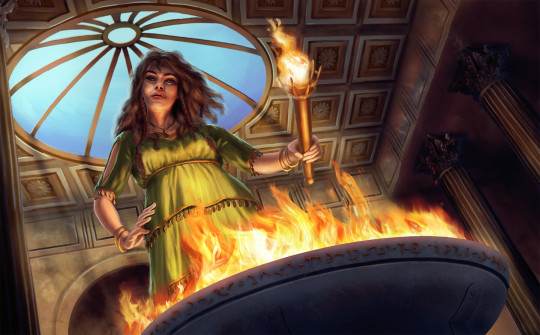
Hestia - Goddess of the Hearth by Markus Stadlober 2019
"Hestia and Hermes: the Greek imagination of motion and place You live among men's and women's beautiful dwelling places On the foot of the big statue of Zeus in Olympia, Phydias represented the twelve Olympian Gods. Between Helios, the sun and Selene, the moon, he arranged them in six couples: Zeus-Hera, Poseidon Amphitrita, Hephaistos-Charis, Apollo-Artemis, Aphrodite-Eros and Hermes-Hestia [Pausanias, Descriptions of Greece 5.11.8]. Hestia and Hermes are not husband and woman, nor brother and sister, nor mother and son either. They are neighbors, or better: friends. Where Hermes loiters is Hestia never far. Where Hestia stays, Hermes can appear at any moment. In its polarity, the couple Hestia-Hermes expresses the tension which is proper to the archaic representation of space. Space needs a center, a fix point from which directions and orientations can be defined. But space is also the locus of motion, and that implies the possibility of transitions, of passage from any point to any other. Hestia and Hermes belong to very archaic, pre-Hellenistic representations. Hestia is the hearth. In modern Greek, istia still means the hearth or the household. The name Hermes comes from herma(x), hermaion or hermaios lophos, heap of stone. Before he became an Olympian God, Hermes was the personification of lithoboly, the gesture of throwing stones on tombs. He was the heap of stone or the wooden pole on a grave, but also the phallos. Hermes unites death and fertility in one figure. Hestia and Hermes, personifications of the hearth and of the protecting grave are the Gods of the domestic domain. They are also the symbols of the gestures of women and men and of their interplay. Through that interplay, the house becomes a unique place in the world, a topos in a cosmos. Hestia and Hermes allow us a glance into Greek domesticity. In their interplay, we can understand something of the Greek household and its works and of hospitality. "You live both on the superficies of the soil, in the beautiful dwellings places of men and women, and you are filled with mutual philía" said a homeric hymn. Hestia and Hermes are the epichthonian Gods, the Gods of the dwelled soil. They are everywhere where people make fire, trace limits, build walls and a roof over their heads. Together, they are the Gods of orientation and of the tracing of limits. (Jean-Pierre Vernant, "Hestia - Hermès. Sur l'expression religieuse de l'espace et du mouvement chez les Grecs:, in Jean-Pierre Vernant, Mythe et pensée chez las Grecs. Étude de psychologie historique, 2 vol., Paris, 1974, pp. 155 - 201. 2)
Hestia sits in the middle. She stands still, but she is ubiquitous. Hermes, the quick one, can never be caught, like mercury. He never appears where he is expected and reigns over the space of travellers. Hestia embodies the gestures of settling down, of enclosing and of keeping. Hermes manifests the gestures of opening, trespassing, and speaks of mobility and of the encounter with the other. He is the God of transitions . He keeps guard on doors and limits, the entrance of cities as well as crossways and has for this reason many heads: Hermes trikephalos, tretrakephalos. Since graves are doors to the underworld, he is in necropoles and cemeteries. He accompanies the souls of the dead to the Hades: Hermes psychagogos, psychopompos. He is the protector of thieves, but he also protects houses from thieves. He is the messenger between Gods and humans: Hermes angelos. All those different aspects of Hermes's activity become only coherent in relation to Hestia's. Hermes makes mobile, Hestia centers. Hestia's place is the hearth, whose deeply rooted stone is a symbol of constancy. Hermes's place is near the door, that he protects from his companions the thieves: Hermes pyloros. Hermes's characteristics and activities are the asymmetrical complements of what Hestia is and does. (Arnold van Gennep, Les rites de passage: étude systématique des rites, Paris: 1909.)
Asymmetrical complementarity At every step of our analysis, we have acknowledged a polarity, or better an asymmetrical complementarity between constancy and change, center and periphery, the closed and the open, the interior and the exterior. That complementarity shapes all spaces, as well as the condition of their inoccupants. We are introduced into a world where by telling me which space you occupy and how, you tell me who you are. Neither term of the polarity can be understood alone, but always only in complement to the other. The tension between these two poles mirrors itself even in the definition of everyone of the terms: there is a Hestia in Hermes, a Hermes in Hestia. As we have already seen with the paradox of hospitality. Hermes's activities can always be interpreted in a hestian light, and vice-versa. In this hestian light, activities like bartering, buying and selling, which are Hermes's prerogatives can be seen as extensions of the logic of gift, over which Hestia reigns. Inversely, Hestia reigns over keeping activities in the house. In Hermes's light, these activities look like an accumulation, an interpretation who became widespread in classical times, where the granaries of the polis, managed by men, were called the Hestia Koinê. So Xenophon compared Hestia with the bee queen, "that stays in the middle of the beehive and sees that honey be well kept". He gives the cells of the beehive the same name that was given to the chambers in which precious goods were kept: thalamoi. As Hestia Koinê, Hestia becomes the symbol of the accumulation power of the city and of the union of their inhabitants around their granaries.
Hestia and Hermes in Greek philosophy Plato gives us a striking example of the absorption of Hermes by Hestia. Hermes is, you remember, the stone heap, the wooden pole on graves. As such, he personifies the central pole of a house, the stem of the big tree in the house patio or the phallos. Hestia is the stone of the hearth, that roots the bouse into the soil, but also the column of smoke that relates the infraworld with the sky. Plato lets the two figures merge into one. Hestia is for him the axis of the world. He plays with etymologicaly not quite founded - homonimities, allowing himself to compare Hestia with the pillar (histiê), the mast of a ship (istós), the woman at the loom, whom he called histia. In Republic, he compares Hestia with the spinning Goddess Anankê, who sits at the center of the universe and whose spindle's motion regulates the revolution of the heavenly spheres. Anankê also means necessity, or the erected phallus. Plato even invents two poetic etymologies for Hestia: ousia, the essence, and hosia, motion."
-Jean Robert, Hestia and Hermes: the Greek imagination of motion and place
9 notes
·
View notes
Text
Het college van B&W van Gennep heeft op 27 augustus 2024 het bestemmingsplan voor de bouw van 199 woningen en zorgvastgoed voor ongeveer 100 cliënten van Dichterbij ter vaststelling naar de gemeenteraad gestuurd. CRA Vastgoed realiseert in samenwerking met zorginstelling Dichterbij een parkachtig woongebied dat aansluit bij de diverse woonbehoeften. Er komt, verdeeld over drie deelgebieden, een gevarieerd aanbod van woningen: appartementen, levensloopbestendige woningen, tweekappers, rij- en hoekwoningen en vrijstaande woningen.
Klanbordgroep heeft geholpen met bestemmingsplan
Het bestemmingsplan is tot stand gekomen met de inbreng van een klankbordgroep en geïnteresseerden tijdens inloopbijeenkomsten. Na de terinzagelegging eind 2023, begin 2024 is het plan aangescherpt op punten als verkeer, stedenbouwkundige inpassing en stikstofberekeningen. Wethouder Peter Stevens: "Ik ben er trots op dat dit plan eindelijk werkelijkheid wordt in deze tijd van woningnood. De Heikant biedt voor veel mensen een thuis in een prachtige omgeving, dichtbij de vele voorzieningen die Gennep heeft. Het plan omvat woningen in alle prijscategorieën, van sociale huur en goedkope koopwoningen tot het middensegment en woningen in de vrije sector."
Ook Dichterbij-bestuurder Monique Caubo is trots op de ontwikkeling in de Heikant: "We kunnen nu voor veel cliënten in Gennep invulling geven aan de veranderende woon- en zorgbehoeften."
Michiel Jongmans, directeur CRA Vastgoed, is ook blij met deze stap: ''Het plan voegt op alle fronten waarde toe: voor huidige én nieuwe bewoners, die hier straks een schitterend thuis vinden. Voor de gemeente, die er bijna 200 marktwoningen bij krijgt, en voor Dichterbij, die voor circa 100 cliënten een fijne woonplek kan realiseren."
Van raadsbesluit naar start bouw in 2025
In de voorbereidende raadsvergadering van 9 september 2024 bespreekt de gemeenteraad het bestemmingsplan. Als de raad op 30 september instemt met het plan, kan de verkoop worden voorbereid. De woningbouw zal de komende jaren in fasen gebeuren, verdeeld over de deelgebieden Oost, West en Zuid. De eerste woningen worden naar verwachting in 2026 opgeleverd.
Kijk voor meer informatie op Ontwikkeling De Heikant Gennep.
0 notes
Text

Kees Nieuwenhuijzen, Jacques Hamelink: ‘De eeuwige dag’, Van Gennep, Amsterdam, 1969
0 notes